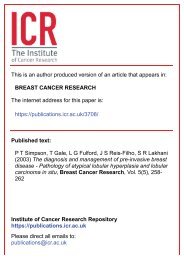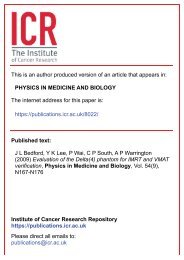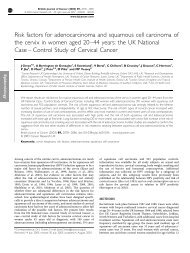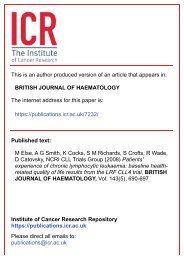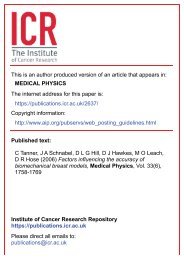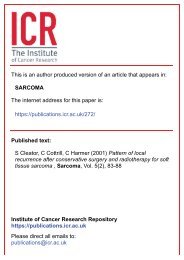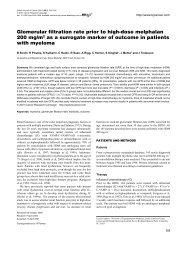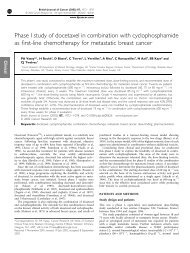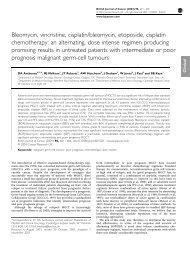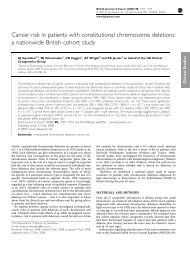Transcriptome analysis of mammary epithelial subpopulations ...
Transcriptome analysis of mammary epithelial subpopulations ...
Transcriptome analysis of mammary epithelial subpopulations ...
You also want an ePaper? Increase the reach of your titles
YUMPU automatically turns print PDFs into web optimized ePapers that Google loves.
BMC Genomics 2008, 9:591http://www.biomedcentral.com/1471-2164/9/591BackgroundThe function <strong>of</strong> complex tissues, such as the <strong>mammary</strong>epithelium, is a product <strong>of</strong> the interactions between theirconstituent cell types. In such tissues, disease states likecancer are essentially a failure <strong>of</strong> this cellular homeostasisand are characterised by insensitivity <strong>of</strong> cells to externalregulatory factors and aberrant cell fate choices. Understandingthe molecular regulation <strong>of</strong> the individual celltypes in complex tissues is, therefore, a prerequisite forunderstanding disease states. Furthermore, advances inmolecular pathology have demonstrated that differentdisease phenotypes correlate with different gene expressionpr<strong>of</strong>iles [1]. In a complex tissue, composed <strong>of</strong> differentcell types with different molecular characteristics, thegene expression pr<strong>of</strong>iles <strong>of</strong> different diseases may reflectthe contribution <strong>of</strong> different cell types to that disease.Therefore, a detailed molecular characterisation <strong>of</strong> the celltypes in a complex tissue is essential for the interpretation<strong>of</strong> the molecular pathology <strong>of</strong> its diseases.The resting adult <strong>mammary</strong> epithelium consists <strong>of</strong> twomain structures, alveoli (which develop into milk-secretinglobulo-alveolar structures upon pregnancy) and ducts(which carry the milk from the lobulo-alveolar structuresto the nipple) [2]. These two structures are themselvescomposed <strong>of</strong> two main <strong>epithelial</strong> cell layers, basal cellsand luminal cells. The basal cell layer mainly consists <strong>of</strong>myo<strong>epithelial</strong> cells which contract in response to oxytocinrelease during lactation to force milk down the ducts tothe nipple. Recent work has demonstrated that the basalcell layer also contains the <strong>mammary</strong> <strong>epithelial</strong> stem cellcompartment [3-7]. The luminal cell layer has beenshown to be composed <strong>of</strong> two functionally distinct lineagesdefined by expression <strong>of</strong> the cell surface proteinsCD24 and Sca-1. CD24 +/High Sca-1 + luminal cells expressestrogen receptor alpha (ER), as well as receptors for prolactinand progesterone (the luminal ER + compartment),while CD24 +/High Sca-1 - luminal cells (the luminal ER -compartment) express genes (at low levels) for milk proteinseven in the virgin and likely include alveolar progenitors[5,7-9].Although it is known that the stem cells can generate allthe myo<strong>epithelial</strong>, luminal ER - and luminal ER + daughtercell types [5], the mechanisms which control cellularhomeostasis, fate determination and lineage commitmentin the <strong>mammary</strong> epithelium are poorly understood. Theyare likely to be a product <strong>of</strong> complex interactions betweencell extrinsic paracrine influences, cell intrinsic transcriptionalregulators and epigenomic modifications [10].Some progress has been made towards understandingsome <strong>of</strong> the cell intrinsic factors involved. For instance,Gata3 was recently identified as a transcription factorimportant in specifying commitment in the general luminallineage [11,12] and Elf5 was shown to be a specifier <strong>of</strong>alveolar cell fate [13]. A number <strong>of</strong> the cell extrinsic (paracrine)factors operating within the <strong>mammary</strong> epitheliumhave also been characterised, such as Wnt-4, which actsdownstream <strong>of</strong> progesterone signalling in ductal sidebranching[14] and the EGF-family member Amphiregulin[15,16], which is produced by ER + cells in response toestrogen and stimulates <strong>mammary</strong> stem cell activity (mostlikely acting indirectly via non-<strong>epithelial</strong> cells and additionalparacrine factors) [17]. The Notch signalling pathwayhas also been shown to be an important determinant<strong>of</strong> luminal cell fate [18,19]. However, the full extent andnature <strong>of</strong> paracrine interactions in the <strong>mammary</strong> gland,and the degree to which the different lineages contributeto them, and are defined by them, is still not fully understood.Gene expression patterns have been previously examinedin the mouse <strong>mammary</strong> gland, either as changes in geneexpression across the whole tissue in developmental timecourses[20,21] or as comparisons between the total epitheliumand the <strong>mammary</strong> stroma [12]. In one report,gene expression patterns were examined in mouse luminaland myo<strong>epithelial</strong> cells purified by flow sorting as wellas in stem cell enriched basal cell populations [6]. However,these stem cell gene signatures were found to be notsignificantly different from the myo<strong>epithelial</strong> signatures,suggesting they were derived from cell populations dominatedby myo<strong>epithelial</strong> cells. The purity <strong>of</strong> the basal stemcell populations remains a persistent problem due the difficulty<strong>of</strong> isolating pure (as opposed to enriched) stem cellfractions. A number <strong>of</strong> gene expression studies have alsobeen carried out on human breast cells. The response <strong>of</strong>human breast epithelium to estrogen has been analysed atthe gene expression level in breast cancer cell lines in vitroand as xenografts [22-24], in normal breast tissue maintainedas xenografts [25] and in normal human ER + breastcells isolated by transduction <strong>of</strong> primary breast <strong>epithelial</strong>cells with a virus carrying an estrogen response elementdriving GFP expression [26]. The comparative geneexpression pr<strong>of</strong>iles <strong>of</strong> normal human myo<strong>epithelial</strong>[27,28], basal non-myo<strong>epithelial</strong> (with a cell surface phenotypeCD10 - CD44 + ) [29] and luminal <strong>epithelial</strong> cells[27-29] have also been examined, as have the gene expressionpr<strong>of</strong>iles <strong>of</strong> different in vitro progenitor (colony-forming)<strong>subpopulations</strong> <strong>of</strong> normal breast <strong>epithelial</strong> cells [18].However, to date no genome-wide transcriptome studyhas made a direct comparison between the two luminal<strong>epithelial</strong> populations (ER - and ER + ) and the basal/myo<strong>epithelial</strong> cells, confounding the molecular characterisation<strong>of</strong> the luminal cells and preventing the <strong>analysis</strong> <strong>of</strong>the lineage commitment <strong>of</strong>, and interactions between, thetwo luminal cell types and the other cell types in thegland.The aim <strong>of</strong> this study, therefore, was to carry out the firstcomprehensive gene expression study which examinedgene expression patterns in the three distinct mouse mam-Page 2 <strong>of</strong> 28(page number not for citation purposes)



